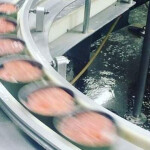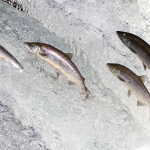China’s fiercely competitive feed market is driving change in the country’s aquaculture sector by advising producers to move away from lower-value freshwater species like tilapia and carp and into higher-priced species.
March 2018 saw an inaugural mandarin fish production summit in the southern city of Foshan. It comes as similar conferences on bass, pangasius, shrimp, and croaker are being organized across the country this spring. The conferences are being organized by fish feed companies with the goal of creating demand and new markets for higher-value products like mandarin, snakehead, croaker, and shrimp.
Also known as Siniperca chuatsi or Chinese perch, the mandarin species is fetching CNY 37 (USD 5.8, EUR 4.7) per 500 grams this month. This makes it a premium species compared to rivals such as the yellowhead catfish (Pelteobagrus fulvidraco), which has been selling at CNY 8.50 (USD 1.34, EUR 1.09) per 500 grams in the same markets.
Another species increasingly in favor with consumers is perch. Also known as the large-mouth black bass, perch (Micropterus salmoides) production started in 1983 in Guangdong Province and is now at 350,000 metric tons per year nationwide – of which 200,000 tons is produced in Guangdong. Prices in March averaged CNY 12.50 (USD 1.98, EUR 1.61) per 500 grams on a farm-gate basis. That’s nearly three times the pond price being paid for tilapia.
The outlook for fish-feed firms is good, considering there’s plenty of room for new species in China. Wage growth has given rise to a wave of new dining trends and restaurant chains and online vendors supplying young urbanites’ surging demand for pangasius, for instance, at the mass-market level and a thriving demand for species like bass, croaker, and mandarin at the more formal midmarket end of the dining scale.
These dining trends will continue to gather pace. Chinese incomes have risen and the economy is shifting to a consumption-driven, urbanized one. Urban wages rose rapidly from 2004 to 2007, at a rate of 13 to 19 percent per year, with average wages doubling from USD 200 (EUR 162) per month in 2007 to USD 424 (EUR 344) for manufacturing workers in 2016.
All the while, the yuan has been rising in value – moving from 8.28 to the dollar in 2000 to 6.84 in 2008, and 6.28 this month – giving Chinese importers and consumers more buying power. And given the current trade-related tensions between Washington and Beijing, the yuan may rise further in value, as its revaluation has become one of China’s favorite means of placating American trade concerns.
A drop in the Vietnamese dong against a stronger yuan, meanwhile, has lowered the price of pangasius to CNY 8.4 (USD 1.33, EUR 1.08) per kilogram average, before rising to CNY 9.8 (USD 1.55, EUR 1.26) per kilo as Vietnamese producers sought to adjust to the currency situation.
Some key Chinese pangasius buyers, including Shanghai Liang Pin Xing and Beijing Xin Liang, have opened sourcing offices in Vietnam to buy up pangasius supply. The fish has proved increasingly popular as a low-cost, low-bone input into booming fast food and convenience retail offerings across a rapidly urbanizing China.
Hence, there is the specter of pangasius ponds replacing tilapia ponds in central and southern China. The trend has begun with a catfish development program starting up at the prestigious Hubei Provincial Fisheries Academy in central China, while pangasius ponds have sprung up in tilapia heartlands like Maoming in Guangdong Province and Wenchang in Hainan Province.
However, there are many factors working against any significant growth of pangasius production in China. Pond rental and labor costs are both significantly lower in Vietnam, and as Chinese authorities continue to ramp up enforcement of environmental regulations, their efforts will decrease the amount of land available for aquaculture. Furthermore, the costs of seedlings, feed, and other operational requirements do not make starting an aquaculture operation easy in China.
Rather than increase domestic production, Chinese firms will probably aim to capitalize on feed sales abroad, especially in Vietnam. They’re likely to seek out deals that give them trading greater access to this sector in return for buying ever greater quantities of fish from the Vietnamese.
On the macro-level, China is moving away from lower-value species that can be imported easily from neighboring states like Vietnam. In fact, Chinese feed companies may be actively discouraging it, as they in turn build market share in Vietnam and other regional producers like Indonesia.
In much the same way that China’s government has sought to rid the country of cheap, dirty manufacturing in favor of higher-value production, so too China’s aquaculture sector is getting squeezed out, especially when it comes to production of low-price species like tilapia. This trend will take some time to play out, but it will start to make its impact felt in the coming decade, with obvious impacts on Western buyers who’ve come to embrace cheap whitefish from China.
Photo courtesy of China Blue






